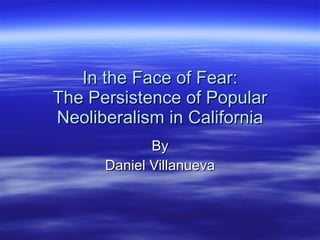In the face of fear
- 1. In the Face of Fear: The Persistence of Popular Neoliberalism in California By Daniel Villanueva
- 2. Outline Origins of an Identity: The Boston Tea Party A Changing identity: The Tax Revolt Movement in California Beyond California: The Spread of Popular Neoliberalism Current Manifestations: âTea Party Protestsâ Conclusions
- 3. The Boston Tea Party Direct Action by colonists in 1773 Response to increasing taxes on imported goods and lack of representation within parliament. Symbolic importance
- 4. The Tax Revolt Movement in California AB 80 (1966) Assembly bill that standardized property values at 25% of the market value. Proposition 1 (1973) Failed tax return backed by Governor Ronald Regan and Howard Jarvis. Proposition 8 (1978) Backed by Legislature and Governor Jerry Brown Proposition 13 (1978) Backed by Howard Jarvis, Paul Gann, and Ronald Regan
- 5. Beyond California Similar movements in other states implemented their own versions of tax reduction and spending limits after proposition 13 passed. Ronald Reganâs reputation for tax reduction and limiting government spending aided in his 1980 Presidential election. Tax reduction, spending reduction, market liberalization, and money supply regulation became the four pillars of Reaganomics (Niskanen, 1988). The liberalizing of the U.S. markets forced other countries to follow suit, as U.S. dollar was international reserve currency (Gowan, 1999).
- 6. Tea Party Protests Tea Party Protests: 2009-Present Fear of taxation and âredistribution of wealthâ Fear of state expenditures from Obamaâs stimulus package. Funded by corporate lobbyists like Koch industries and run by Americans for Prosperity, and FreedomWorks. Supported by the Howard Jarvis Taxpayer Association.
- 7. The Role of Fear When emotions, like fear, are cued, voters are more likely to be persuaded and vigilant on an issue (Brader, 2005). The combination of real and imagined threats engendered fear in each instance that shape popular perspective and decision making.
- 8. The Role of Symbolism Affinities manufactured with the Boston Tea Party are used to justify legitimacy of movements, and to act out and adhere to an imagined identity that has come to symbolize the essence of what it means to be âAmerican.â
- 9. Conclusions The use of fear to persuade and convince individuals has been combined with the symbolic imagery of the Boston Tea Party to create/recreate a popular identity that is congruent with Neoliberal policy despite being contrary to individual interests.
- 10. The End
Editor's Notes
- #5: Video start @1:00 minutes










